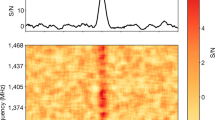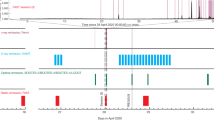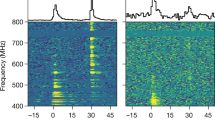Abstract
Fast radio bursts are millisecond-duration, bright radio signals (fluence 0.1–100 Jy ms) emitted from extragalactic sources of unknown physical origin. The recent CHIME/FRB and STARE2 detection of an extremely bright (fluence ~MJy ms) radio burst from the Galactic magnetar SGR 1935+2154 supports the hypothesis that (at least some) fast radio bursts are emitted by magnetars at cosmological distances. In follow-up observations totalling 522.7 h on source, we detect two bright radio bursts with fluences of 112 ± 22 Jy ms and 24 ± 5 Jy ms, respectively. Both bursts appear to be affected by interstellar scattering and we measure significant linear and circular polarization for the fainter burst. The bursts are separated in time by ~1.4 s, suggesting a non-Poissonian, clustered emission process—similar to those seen in some repeating fast radio bursts. Together with the burst reported by CHIME/FRB and STARE2, as well as a much fainter burst seen by FAST (fluence 60 mJy ms), our observations demonstrate that SGR 1935+2154 can produce bursts with apparent energies spanning roughly seven orders of magnitude, and that the burst rate is comparable across this range. This raises the question of whether these four bursts arise from similar physical processes, and whether the fast radio burst population distribution extends to very low energies (~1030 erg, isotropic equivalent).
This is a preview of subscription content, access via your institution
Access options
Access Nature and 54 other Nature Portfolio journals
Get Nature+, our best-value online-access subscription
$29.99 / 30 days
cancel any time
Subscribe to this journal
Receive 12 digital issues and online access to articles
$119.00 per year
only $9.92 per issue
Buy this article
- Purchase on Springer Link
- Instant access to full article PDF
Prices may be subject to local taxes which are calculated during checkout




Similar content being viewed by others
Data availability
The data that support the plots within this paper and other findings of this study are available from https://doi.org/10.5281/zenodo.4044453 or from the corresponding author upon reasonable request.
Code availability
The pipeline written to process the baseband data can be found at https://github.com/pharaofranz/frb-baseband, while the code used to calculate the posterior distribution and generate Fig. 3 can be found at https://github.com/MJastro95. jive5ab can be retrieved from https://github.com/jive-vlbi/jive5ab, Heimdall is hosted at https://sourceforge.net/projects/heimdall-astro/ and FETCH can be found at https://github.com/devanshkv/fetch. The pulsar package DSPSR is hosted at https://sourceforge.net/projects/dspsr/, while SIGPROC was retrieved from https://github.com/SixByNine/sigproc.
References
Platts, E. et al. A living theory catalogue for fast radio bursts. Phys. Rep. 821, 1–27 (2019).
Chen, G., Ravi, V. & Lu, W. The multiwavelength counterparts of fast radio bursts. Astrophys. J. 897, 146 (2020).
Scholz, P. et al. Simultaneous X-ray, gamma-ray, and radio observations of the repeating fast radio burst FRB 121102. Astrophys. J. 846, 80 (2017).
Marcote, B. et al. A repeating fast radio burst source localized to a nearby spiral galaxy. Nature 577, 190–194 (2020).
CHIME/FRB Collaboration A bright millisecond-duration radio burst from a Galactic magnetar. Preprint at https://arxiv.org/abs/2005.10324 (2020).
Bochenek, C. D. et al. A fast radio burst associated with a Galactic magnetar. Preprint at https://arxiv.org/abs/2005.10828 (2020).
CHIME/FRB Collaborationet al. The CHIME Fast Radio Burst Project: system overview. Astrophys. J. 863, 48 (2018).
Bochenek, C. D. et al. STARE2: detecting fast radio bursts in the Milky Way. Publ. Astron. Soc. Pac. 132, 034202 (2020).
Ridnaia, A. et al. A peculiar hard X-ray counterpart of a Galactic fast radio burst. Preprint at https://arxiv.org/abs/2005.11178 (2020).
Mereghetti, S. et al. INTEGRAL discovery of a burst with associated radio emission from the magnetar SGR 1935+2154. Astrophys. J. Lett. 898, L29 (2020).
Tavani, M. et al. AGILE detection of a hard X-ray burst in temporal coincidence with a radio burst from SGR 1935+2154. Astronomer’s Telegram 13686 (2020).
Li, C.K. et al. Identification of a non-thermal X-ray burst with the Galactic magnetar SGR 1935+2154 and a fast radio burst with Insight-HXMT. Preprint at https://arxiv.org/abs/2005.11071 (2020).
Younes, G. et al. X-ray and radio observations of the magnetar SGR J1935+2154 during its 2014, 2015, and 2016 outbursts. Astrophys. J. 847, 85 (2017).
Zhang, C. F. et al. A highly polarised radio burst detected from SGR 1935+2154 by FAST. Astronomer’s Telegram 13699 (2020).
Nan, R. et al. The Five-Hundred Aperture Spherical Radio Telescope (FAST) Project. Int. J. Mod. Phys. D 20, 989–1024 (2011).
Michilli, D. et al. An extreme magneto-ionic environment associated with the fast radio burst source FRB 121102. Nature 553, 182–185 (2018).
CHIME/FRB Collaboration CHIME/FRB discovery of eight new repeating fast radio burst sources. Astrophys. J. Lett. 885, L24 (2019).
Hessels, J. W. T. et al. FRB 121102 bursts show complex time–frequency structure. Astrophys. J. Lett. 876, L23 (2019).
Gourdji, K. et al. A sample of low-energy bursts from FRB 121102. Astrophys. J. Lett. 877, L19 (2019).
Majid, W. A. et al. A dual-band radio observation of FRB 121102 with the Deep Space Network and the detection of multiple bursts. Astrophys. J. Lett. 897, L4 (2020).
Whitney, A., Kettenis, M., Phillips, C. & Sekido, M. VLBI Data Interchange Format (VDIF). In International VLBI Service for Geodesy and Astronomy: 2010 General Meeting Proceedings (eds Behrend, D. & Baver, K. D.) 192–196 (NASA, 2010).
van Straten, W. & Bailes, M. dspsr: digital signal processing software for pulsar astronomy. Publ. Astron. Soc. Aust. 28, 1–14 (2011).
Agarwal, D., Aggarwal, K., Burke-Spolaor, S., Lorimer, D.R. & Garver-Daniels, N. FETCH: a deep-learning based classifier for fast transient classification. Mon. Not. R. Astron. Soc. 497, 1661–1674 (2020).
Li, C. K. et al. Updated catalog of X-ray bursts of SGR J1935.2154 from Insight-HXMT observations. GRB Coordinates Network 28027 (2020).
Zhang, S.-N. et al. Overview to the Hard X-ray Modulation Telescope (Insight-HXMT) satellite. Sci. China Phys. Mech. Astron. 63, 249502 (2020).
Keimpema, A. et al. The SFXC software correlator for very long baseline interferometry: algorithms and implementation. Exp. Astron. 39, 259–279 (2015).
Cordes, J. M. & McLaughlin, M. A. Searches for fast radio transients. Astrophys. J. 596, 1142–1154 (2003).
Zhong, S.Q., Dai, Z.G., Zhang, H.M. & Deng, C.M. On the distance of SGR 1935+2154 associated with FRB 200428 and hosted in SNR G57.2+0.8. Astrophys. J. Lett. 898, L5 (2020).
Oppermann, N., Yu, H.-R. & Pen, U.-L. On the non-Poissonian repetition pattern of FRB121102. Mon. Not. R. Astron. Soc. 475, 5109–5115 (2018).
Oppermann, N. et al. Repeating fast radio bursts with WSRT/Apertif. Astron. Astrophys. 635, A61 (2020).
Kirsten, F. et al. Simultaneous multi-frequency limits on radio emission at the time of a bright X-ray burst from SGR 1935+2154. Astronomer’s Telegram 13735 (2020).
Hurley, K. et al. IPN triangulation of a bright burst from SGR 1935+2154 on 2020-05-10 at 06:12 UT. GRB Coordinates Network 27714 (2020).
Kramer, M., Stappers, B. W., Jessner, A., Lyne, A. G. & Jordan, C. A. Polarized radio emission from a magnetar. Mon. Not. R. Astron. Soc. 377, 107–119 (2007).
Camilo, F., Reynolds, J., Johnston, S., Halpern, J. P. & Ransom, S. M. The magnetar 1E 1547.0−5408: radio spectrum, polarimetry, and timing. Astrophys. J. 679, 681–686 (2008).
Levin, L. et al. Radio emission evolution, polarimetry and multifrequency single pulse analysis of the radio magnetar PSR J1622−4950. Mon. Not. R. Astron. Soc. 422, 2489–2500 (2012).
Petroff, E. et al. A real-time fast radio burst: polarization detection and multiwavelength follow-up. Mon. Not. R. Astron. Soc. 447, 246–255 (2015).
Masui, K. et al. Dense magnetized plasma associated with a fast radio burst. Nature 528, 523–525 (2015).
Ravi, V. et al. The magnetic field and turbulence of the cosmic web measured using a brilliant fast radio burst. Science 354, 1249–1252 (2016).
Wood, J., Fermi-GBM Team & GBM-LIGO/Virgo Group. LIGO/Virgo S190930t: upper limits from Fermi-GBM observations. GRB Coordinates Network 25887 (2019).
Wood, J. & Fermi-GBM Team. Fermi-LAT ANTARES coincidence: upper limits from Fermi-GBM observations. GRB Coordinates Network 26676 (2020).
Lin, L. et al. Stringent upper limits on pulsed radio emission during an active bursting phase of the Galactic magnetar SGRJ1935+2154. Preprint at https://arxiv.org/abs/2005.11479 (2020).
Lin, L. et al. Burst properties of the most recurring transient magnetar SGR J1935+2154. Astrophys. J. 893, 156 (2020).
Younes, G. et al. A possible polar origin for the FRB associated with a Galactic magnetar. Preprint at https://arxiv.org/abs/2006.11358 (2020).
Kaspi, V. M. & Beloborodov, A. M. Magnetars. Annu. Rev. Astron. Astrophys. 55, 261–301 (2017).
Lower, M. E., Shannon, R. M., Johnston, S. & Bailes, M. Spectropolarimetric properties of Swift J1818.0−1607: a 1.4 s radio magnetar. Astrophys. J. Lett. 896, L37 (2020).
Burgay, M. et al. Search for FRB and FRB-like single pulses in Parkes magnetar data. In Pulsar Astrophysics: The Next Fifty Years (eds Weltevrede, P. et al.) 319–321 (IAU, 2018).
Spitler, L. G. et al. A repeating fast radio burst. Nature 531, 202–205 (2016).
CHIME/FRB Collaboration. Periodic activity from a fast radio burst source. Nature 582, 351–355 (2020).
Lyutikov, M., Barkov, M. V. & Giannios, D. FRB periodicity: mild pulsars in tight O/B-star binaries. Astrophys. J. Lett. 893, L39 (2020).
Beniamini, P., Wadiasingh, Z. & Metzger, B. D. Periodicity in recurrent fast radio bursts and the origin of ultralong period magnetars. Mon. Not. R. Astron. Soc. 496, 3390–3401 (2020).
Levin, Y., Beloborodov, A. M. & Bransgrove, A. Precessing flaring magnetar as a source of repeating FRB 180916.J0158+65. Astrophys. J. Lett. 895, L30 (2020).
Grossan, B. Periodic windowed behavior in SGR1935+2154 SGR bursts. Preprint at https://arxiv.org/abs/2006.16480 (2020).
Scholz, P. & CHIME/FRB Collaboration. A bright millisecond-timescale radio burst from the direction of the Galactic magnetar SGR 1935+2154. Astronomer’s Telegram 13681 (2020).
Bochenek, C. et al. Independent detection of the radio burst reported in ATel #13681 with STARE2. Astronomer’s Telegram 13684 (2020).
Li, X. B. et al. Insight-HXMT detection of a short bright burst from SGR 1935+2154. GRB Coordinates Network 27688 (2020).
Gendreau, K. C. et al. The Neutron star Interior Composition Explorer (NICER): design and development. Proc. SPIE 9905, 99051H (2016).
Gehrels, N. et al. The Swift Gamma-Ray Burst Mission. Astrophys. J. 611, 1005–1020 (2004).
Meegan, C. et al. The Fermi Gamma-ray Burst Monitor. Astrophys. J. 702, 791–804 (2009).
Lorimer, D. R. SIGPROC: pulsar signal processing programs. Astrophysics Source Code Library ascl:1107.016 (2011).
van Straten, W. et al. PSRCHIVE: development library for the analysis of pulsar astronomical data. Astrophysics Source Code Library ascl:1105.014 (2011).
van Straten, W., Manchester, R. N., Johnston, S. & Reynolds, J. E. PSRCHIVE and PSRFITS: definition of the Stokes parameters and instrumental basis conventions. Publ. Astron. Soc. Aust. 27, 104–119 (2010).
Han, J. L., Manchester, R. N., van Straten, W. & Demorest, P. Pulsar rotation measures and large-scale magnetic field reversals in the Galactic disk. Astrophys. J. Suppl. Ser. 234, 11 (2018).
Johnston, S. & Kerr, M. Polarimetry of 600 pulsars from observations at 1.4 GHz with the Parkes radio telescope. Mon. Not. R. Astron. Soc. 474, 4629–4636 (2018).
Everett, J. E. & Weisberg, J. M. Emission beam geometry of selected pulsars derived from average pulse polarization data. Astrophys. J. 553, 341–357 (2001).
Ursi, A. et al. AGILE detection of a short and hard X-ray burst possibly related to SGR 1935+2154. GRB Coordinates Network 27687 (2020).
Cordes, J. M. & Lazio, T. J. W. NE2001.I. A new model for the Galactic distribution of free electrons and its fluctuations. Preprint at https://arxiv.org/abs/astro-ph/0207156 (2002).
Yao, J. M., Manchester, R. N. & Wang, N. A new electron-density model for estimation of pulsar and FRB distances. Astrophys. J. 835, 29 (2017).
Kirsten, F. et al. Probing pulsar scattering between 120 and 280 MHz with the MWA. Astrophys. J. 874, 179 (2019).
Geyer, M. et al. Scattering analysis of LOFAR pulsar observations. Mon. Not. R. Astron. Soc. 470, 2659–2679 (2017).
Meyers, B. W. et al. Spectral flattening at low frequencies in Crab giant pulses. Astrophys. J. 851, 20 (2017).
Williamson, I. P. Pulse broadening due to multiple scattering in the interstellar medium. Mon. Not. R. Astron. Soc. 157, 55 (1972).
Gaensler, B. M. GRB 140705A/SGR 1935+2154: probable association with supernova remnant G57.2+0.8. GRB Coordinates Network 16533 (2014).
Simard, D. & Ravi, V. Scintillation can explain the spectral structure of the bright radio burst from SGR 1935+2154. Astrophys. J. Lett. 899, L21 (2020).
Verrecchia, F. et al. AGILE detection of a burst from SGR 1935+2154 on May 10, 2020. GRB Coordinates Network 27727 (2020).
Acknowledgements
We thank R. Blaauw and P. van Dijk for scheduling and running the observations at Westerbork. At Onsala we acknowledge the help of E. Varenius with running the observations at X-band on the Onsala 20 m telescope and we thank M. Mickaliger for helping with the initial set-up for running FETCH. We appreciate the help of N. Degenaar with interpreting the X-ray observations and we are indebted to A. Keimpema, who modified SFXC to our needs. We also thank G. Younes for useful discussions; and we thank S. Kulkarni, V. Ravi, W. Majid, J. Katz, A. Tohuvavohu and B. Grossan for helpful comments. F.K. acknowledges support by the Swedish Research Council. J.v.d.E. is supported by the Netherlands Organisation for Scientific Research (NWO). Research at the University of Amsterdam and ASTRON is supported by an NWO Vici grant to J.W.T.H. This work is based in part on observations carried out using the 32 m radio telescope operated by the Institute of Astronomy of the Nicolaus Copernicus University in Toruń (Poland) and supported by a Polish Ministry of Science and Higher Education SpUB grant.
Author information
Authors and Affiliations
Contributions
F.K. wrote and ran the search pipeline, led the observations at Onsala, interpreted the data and led the paper writing. M.P.S. ran the scattering analysis, created Figs. 1–4 and Extended Data Fig. 1, and populated Supplementary Table 1. M.J. performed the Weibull analysis and wrote the associated sections. M.P.S. and M.J. co-led the Westerbork observing campaign. K.N. ran the polarization analysis, created Extended Data Fig. 2, and wrote the respective sections. J.v.d.E. searched and analysed the X-ray observations, wrote the respective sections and populated Supplementary Table 2. J.W.T.H interpreted the data scientifically, supervised student work and wrote parts of the manuscript. M.P.G. led the observations at Toruń and wrote the section describing those data. J.Y. supported the observations at Onsala and also interpreted the data.
Corresponding author
Ethics declarations
Competing interests
The authors declare no competing interests.
Additional information
Peer review information Nature Astronomy thanks George Younes and the other, anonymous, reviewer(s) for their contribution to the peer review of this work.
Publisher’s note Springer Nature remains neutral with regard to jurisdictional claims in published maps and institutional affiliations.
Extended data
Extended Data Fig. 1 Overview of the observations of SGR 1935+2154 during this campaign.
Panels (a) and (b) both span 33 days, with observations colourcoded by observing frequency. Note the gap of 25 days between (a) and (b). No observations were conducted during that time period. Vertical lines indicate the times of reported bursts. Solid line: events found in our campaign; long-dashed: CHIME and STARE2 detections53,54; dotted: detection by FAST14; dash-dotted: X-ray bursts as reported by α) Ursi et al.65, β) Hurley et al.32 and Verrecchia et al.74, γ) a Fermi/GBM trigger on 2020 May 20 at 21:47:07.548 UT. During X-ray events β) and γ) no radio counterparts were found in any of our data, which allows us to place upper limits on the fluences — as listed in Table 1. Unfortunately we can draw no conclusions from our data coincident with event α) because Wb was in a recording gap and O8 was affected by strong RFI.
Extended Data Fig. 2 The polarisation position angle swing (panels a and b) and average polarisation profiles (panels c and d) of PSR J1935+1616.
Shown are Stokes I (black), linear polarisation (red) and circular polarisation (blue). For comparison, the pulsar profile and PPA from the literature (at 1.4 GHz63) is shown using more transparent colours. (a) and (c): before applying the leakage calibration discussed in the text and Faraday-correcting using the true rotation measure62 of the pulsar (-10.2 rad m-2), that is we are also ignoring the delay between polarisation hands. (b) and (d): The leakage calibrated data, Faraday-corrected using the RM determined using the PSRCHIVE tool rmfit, which, in essence, accounts for the delay between the polarisation hands. This illustrates the polarisation calibration used for the SGR 1935+2154 bursts. Note that the absolute value of the PPA has been shifted to visually compare our observations with the literature.
Supplementary information
Supplementary Information
Supplementary Tables 1 and 2.
Rights and permissions
About this article
Cite this article
Kirsten, F., Snelders, M.P., Jenkins, M. et al. Detection of two bright radio bursts from magnetar SGR 1935 + 2154. Nat Astron 5, 414–422 (2021). https://doi.org/10.1038/s41550-020-01246-3
Received:
Accepted:
Published:
Issue Date:
DOI: https://doi.org/10.1038/s41550-020-01246-3
This article is cited by
-
A link between repeating and non-repeating fast radio bursts through their energy distributions
Nature Astronomy (2024)
-
Magnetar spin-down glitch clearing the way for FRB-like bursts and a pulsed radio episode
Nature Astronomy (2023)
-
Quasi-periodic sub-pulse structure as a unifying feature for radio-emitting neutron stars
Nature Astronomy (2023)
-
Detection of ultra-fast radio bursts from FRB 20121102A
Nature Astronomy (2023)
-
Fast radio bursts at the dawn of the 2020s
The Astronomy and Astrophysics Review (2022)



